Vegetarian Meals
Error message
- Deprecated function: The each() function is deprecated. This message will be suppressed on further calls in _menu_load_objects() (line 579 of /home4/lenareci/public_html/includes/menu.inc).
- Notice: Trying to access array offset on value of type int in element_children() (line 6598 of /home4/lenareci/public_html/includes/common.inc).
- Notice: Trying to access array offset on value of type int in element_children() (line 6598 of /home4/lenareci/public_html/includes/common.inc).
- Notice: Trying to access array offset on value of type int in element_children() (line 6598 of /home4/lenareci/public_html/includes/common.inc).
- Notice: Trying to access array offset on value of type int in element_children() (line 6598 of /home4/lenareci/public_html/includes/common.inc).
- Notice: Trying to access array offset on value of type int in element_children() (line 6598 of /home4/lenareci/public_html/includes/common.inc).
- Notice: Trying to access array offset on value of type int in element_children() (line 6598 of /home4/lenareci/public_html/includes/common.inc).
- Notice: Trying to access array offset on value of type int in element_children() (line 6598 of /home4/lenareci/public_html/includes/common.inc).
- Notice: Trying to access array offset on value of type int in element_children() (line 6598 of /home4/lenareci/public_html/includes/common.inc).
- Notice: Trying to access array offset on value of type int in element_children() (line 6598 of /home4/lenareci/public_html/includes/common.inc).
- Notice: Trying to access array offset on value of type int in element_children() (line 6598 of /home4/lenareci/public_html/includes/common.inc).
- Notice: Trying to access array offset on value of type int in element_children() (line 6598 of /home4/lenareci/public_html/includes/common.inc).
- Notice: Trying to access array offset on value of type int in element_children() (line 6598 of /home4/lenareci/public_html/includes/common.inc).
- Notice: Trying to access array offset on value of type int in element_children() (line 6598 of /home4/lenareci/public_html/includes/common.inc).
- Notice: Trying to access array offset on value of type int in element_children() (line 6598 of /home4/lenareci/public_html/includes/common.inc).
- Notice: Trying to access array offset on value of type int in element_children() (line 6598 of /home4/lenareci/public_html/includes/common.inc).
- Notice: Trying to access array offset on value of type int in element_children() (line 6598 of /home4/lenareci/public_html/includes/common.inc).
- Deprecated function: implode(): Passing glue string after array is deprecated. Swap the parameters in drupal_get_feeds() (line 394 of /home4/lenareci/public_html/includes/common.inc).
This creamy bechamel is flavored with fresh lemon juice for an extra special sauce. It pairs well with steamed vegetables, grilled chicken, or in other variety of ways, it is also typically used as a base for other sauces!!
INGREDIENTS
4 tablespoons Butter
4 tablespoons Flour
1 cup Milk
1 1/2 cups of Water
3 tablespoons Fresh Lemon Juice
Salt to taste
1/4 tsp. Nutmeg
INSTRUCTIONS
In a heavy saucepan or skillet, melt the butter over medium to medium-low heat. Melt the butter until it is completely melted, but do not let it brown.
Add the flour all at once into the pan with the butter. It will clump up at first. Stir it with a wooden spoon to remove the clumps and create a smooth mixture.
Don’t let the roux get brown, as this will affect the flavor and color of the bechamel sauce.
Add 1 tablespoon of milk at a time, mix it in quickly to moisten the roux. Distribute it well throughout the roux, the mixture will slightly be wet but not runny.
Whisk in the remaining milk and water into the pan with one hand while whisking with the other hand and keep stirring for a few more minutes.
Add the lemon juice and season with salt, and nutmeg. Continue to cook until it reaches the desired consistency. It should be somehow runny and not too thick.
Pour it immediately over steamed vegetables.
You can use it also as a base for other sauces.
“Zenkoul” is a traditional Lebanese recipe mainly known in West Bekaa, prepared during Lent and on Good Friday. The method of preparation varies from one village to another: some add sumac instead of pomegranate molasses, others use vinegar instead of lemon juice; dried mint is sometimes sprinkled at the end.
Zenkoul is a similar recipe to Kebbit el Rahib (Monk’s Kebbeh) and Mansoufeh all prepared with the simple basic ingredients bulgur and flour but vary with their sauce.
All in all, Zenkoul is a nutritious and delicious dish.
Total Servings: 5
Preparation Time: 1 hour
INGREDIENTS
For the dough
1 cup Bulgur, brown fine bulgur
1/2 cup Flour
1 tsp. Pepper
1 tsp. Salt
3/4 cup Water
For the sauce
1/2 cup Chickpea, soaked overnight
1/4 cup Rice
2 medium Onions, finely chopped
6 Cloves Garlic, minced
4 cups Water
2 Fresh Lemon Juice, or, 1 tbsp. Pomegranate Molasses
Olive Oil

The small dough balls that are called “zenkoul”
Dough
Mix flour, bulgur, pepper, salt, and water and knead to form the dough
Take small pieces of dough and make small balls of zenkoul with the palm of your hands, leave aside
The sauce is simple and delicious
In a large cooking pot, put the soaked chickpeas with 2 cups of water, let it boil, then transfer to low heat until the chickpeas become soft.
In a pan, fry the onion until soft, add the minced garlic.
When the water of the chickpeas starts decreasing, add the 2 remaining cups of water, the fried onion, garlic, and the zenkoul.
Add the rice and cook for 20 minutes until the “zenkoul” is cooked and the sauce is thick.
Add the lemon juice, or, the pomegranate molasses.
Serve hot.
Swiss Chard leaves, earthy taste, bright green color, Tasty and highly nutritious vegan Lebanese diet dish that the stuffing looks like a tabbouleh made with rice instead of burghul!!
INGREDIENTS
1 cup of Chickpeas, soaked in water overnight
1 cup of Short Rice
1 large bunch of Swiss Chard Leaves
2 Medium Tomatoes, thinly sliced
1 medium Onion, thinly sliced
1 cup Fresh Parsley, finely chopped
Few Leaves of Fresh Mint, finely chopped
1 Large Fresh Lemon, squeezed
1 cup Olive Oil, divided in half
Salt, to taste
7 spices, to taste
METHOD
Wash the swiss chard leaves thoroughly to release any sand. Remove their stalks, you might also need to cut the leaves in half if they seem large. Then blanch the leaves by plunging them into a pot of boiling water, for approximately 2 minutes. Drain and cool the leaves in ice water to stop the cooking procedure. Cool the leaves before stuffing.

Drain and prepare the stuffing.
Peel the chickpeas and mix them with the rice, thinly diced tomatoes, minced parsley, minced mint, minced onion, squeezed lemon, half cup olive oil, salt, and pepper.

Stuff the leaves by putting one tablespoon on each leave, keeping at least 1 cm from each side of the leave without filling. Fold the edges and roll each leave until it is completely rolled up.
Place 2 tablespoons of olive oil at the bottom of a cooking pot. Line the bottom of the pot with slices of tomatoes over the olive oil to prevent the chard leaves from sticking. Start arranging the stuffed chard leaves side by side. Once the bottom of the saucepan is full, arrange another layer on top until all are inside the pan.


Pour on top the remaining juice from the filling, and add water to the limit of the rolled leaves and have them covered, add the other half cup of olive oil and a squeeze of one lemon and cover the top of the stuffed leaves with a dish (resistant to heat) to keep them in place and avoid them to open. Cover the saucepan, bring to boil, reduce heat to low and simmer for 10 to 15 minutes or until the rice is cooked.
Carefully remove the dish and remove the chard stuffed leaves from the heat.
Serve hot or cold.
Fava Beans are fresh from the pod they are bright green and very pretty. They’re special, they have a mild, creamy flavor that compliments many spring dishes. They have a short season. Most forms of fava beans need to be peeled before eating!
INGREDIENTS
2 kgs Fava Beans
1 cup Tahini Paste
1/2 cup Lemon Juice
2 Garlic Cloves, pressed
1/2 tsp. Salt
½ cup Water, depending on desired consistency
METHOD
Open the fava bean pod and remove the beans, usually the pod carries around 4 or 5 beans.
Fill a pot with some water to cover the beans and boil for around one minute, then remove and transfer to a bowl of iced water.
Fava beans should be ready now to peel. Once the shells are removed, steam or boil those beans for a short time just to cook for more tenderness.
Drain and prepare the tahini sauce
In a medium bowl, combine the crushed garlic and salt. Add the tahini and gradually add the lemon juice. Use a whisk or fork to combine mixture until the mixture is thoroughly blended. Taste to adjust either with more lemon juice or with water to reach the desired consistency. The tahini sauce will turn into a creamy, smooth, and light-colored sauce.
Add the peeled fava beans to the tahini sauce. Drizzle with olive oil. Sprinkle with dried mint. Serve with pita bread.

Cauliflower or Arnabeet Mekli is hard to resist, it is a stunning side dish, or starter, or even a full lunch meal, especially with a basket of Lebanese pita bread and the garlicky tahini sauce!!
INGREDIENTS
1 large head of Cauliflower, cut into small florets
1 tsp. Salt
3 cups Vegetable Oil
INGREDIENTS FOR TAHINI SAUCE
1 cup Tahini
3/4 cup Lukewarm Water
2 Cloves of Garlic
1/4 cup Fresh Squeezed Lemon Juice
Salt to taste
METHOD
Cut the cauliflower into small florets, wash and place in a cooking pan filled with water, add salt, bring to a boil and cook for about 10 minutes.
Drain and let cool.
Prepare a deep-frying pan, heat the oil, and place the florets in the hot oil making sure the florets are not placed crowded in the pan. Keep turning the florets until they are browned on all sides. Transfer the browned florets to a plate, lined with a paper towel to absorb excess oil. Continue with the remaining florets.
MAKING THE TAHINI SAUCE - TARATOUR

In a bowl, crush the garlic, add salt, tahini and gradually add the lemon. Stir together well until it becomes a soft creamy consistency.
Traditional Lebanese vegan dish is known as Hindbeh.
Sautéed Dandelion are nutritious and delicious wild food, extremely easy to cook and, it is also economical. It is a very tasty, and simple dish. Cultivated dandelion greens grow wild on grasslands, they are long and slender, with a pleasantly bitter flavor...

INGREDIENTS
2 bunches of Hindbeh, Dandelion leaves, approx. 500grams
1 large Onion, chopped
8 cloves of Garlic, crushed
1 cup chopped Coriander
1/2 tsp. Salt, or more to taste
Olive Oil for frying
Caramelized Onions and Pine Nuts for the topping
4 large Onions, sliced
1/4 cup Pine Nuts
1/2 cup Olive Oil
1 fresh squeezed Lemon, more lemons quartered to squeeze separately
PREPARATION
Wash the dandelion leaves very well to help wash away bitterness, then chop the leaves, the stems are eatable, I only trim about an inch off the bottom and discard. Now soak in some salted water for approximately 15 minutes. Rinse again and add to a pot of boiling water with a tablespoon of salt and boil uncovered on medium heat for another 15 minutes, making sure you push them down, so they blanch evenly.
Alternatively, you can also steam the dandelion; this tends to keep more nutrients in it however it may yield a slightly bitter taste.
While they are cooking, prepare a large bowl with ice cubes and cold water. Test the tenderness of the dandelion by rubbing a stem or two between your fingers. If they are slightly squishy, then they are cooked. Immediately remove the dandelion from the heat, drain, and transfer to the ice-water bath to stop the cooking process and set the color.
Once done, drain the cooled dandelion in a colander and squeeze as much excess water as possible with your hands, then spread them on a cutting board. Sprinkle salt and mix well.
Meanwhile, add the onions and crushed garlic to a frying pan, fry with olive oil. When onions and garlic become soft and caramelized reduce the heat to low, and add the chopped coriander, fry for one more minute then add the cooked dandelion to the frying pan, pulling apart the small clumps with a fork, mix well, and cook for 5 more minutes.
Caramelized Onions and Pine nuts
In a separate frying pan, and on medium-high heat, add olive oil, when it is warm enough add the sliced onions and sauté stirring occasionally until caramelized to a golden-brown color, the main thing is to brown without burning. You want them to be sweet and silky. While some crispy and burnt edges are desired, any excessively blackened bits will taste bitter.
In another frying pan and over low heat, fry the pine nuts with the remaining olive oil, beware pine nuts brown very fast
Pour the fried dandelions into your serving plate, add lemon juice to taste, drizzle with 2 tablespoons of olive oil, and garnish with the caramelized onions, and fried pine nuts.
Serve cold with Lebanese pita bread and enjoy.
Leftovers can last a few days in the fridge if covered well
Makhlouta is a traditional simple Lebanese stew made from at least 6 types of the loveliest flavors and healthiest whole grains which is full of vitamins and fibers. Its flavor exceeds mostly from the fried onions and cumin.







INGREDIENTS, (5 servings)
1/2 cup of Chickpeas
1/2 cup of Pinto Beans
1/2 cup of Wheat grains
1/4 cup of Lentils
1/4 cup of Rice
1/4 cup of Burghul, (cracked wheat)
1 Large Potato head, cut in small pieces
3 large Onions, finely chopped
1/2 cup of Olive Oil, for frying
1 teaspoon of Salt
1 teaspoon Cumin powder


PREPARATION
Soaking the beans is the first and most important step for cooking Makhlouta
Before a night, soak each kind of the grains in a separate bowl, make sure to contain enough water as the grains will grow to triple from their main size after soaking. On the next day, empty the water and rinse the beans.
Make ready to cook, first fill a deep cooking pot with at least 12 cups of water, then add the wheat, let it boil, and move to a lower heat for 20 minutes.
Then add the chickpeas and let it cook with the wheat for another 20 minutes.
Now add the pinto beans to the wheat and chickpeas, let it cook for another 20 minutes.
The main purpose we add the beans gradually since the wheat needs the longest time to get cooked, followed by chickpeas and then the pinto beans. (The 20 minutes I suggest may vary if the beans are new or old. Also, it depends on the stove heat. The beans are done when you can smash it with your finger to find how soft it became).
Soak the rice and burghul just for 10 minutes before adding to the beans. Cut the potato head into small pieces. Rinse the lentils.
Currently, prepare a frying pan with adding 5 tablespoons of olive oil and fry the onions until golden brown.
After the pinto beans have boiled for 20 minutes, add the rice, lentils, burghul, potatoes, salt, cumin and the fried onions dumped with their oil into the cooking pot, mix well and let simmer for another 30 minutes while stirring occasionally.
Let stand for 5 minutes before serving, until all the flavors are combined.
Serve hot with toasted or fried bread.
TIPS
If the water level decreases while cooking, (absorbed by grains), you can always add more water in the cooking pot.
Cooking time may vary, as mentioned above, the purpose is that the beans might not be new, and this will make the cooking time longer, around half an hour.
The cooking of beans turns to be done when the grains become soft enough
You can store the leftovers in the fridge for 2-3 days, and when reheating, add a little water as needed.
This makes the perfect side dish to any meal, crispy, sweet, and tender all in one, they are tempting, quick and healthy, awesome in taste, you will fall in love with it!!
INGREDIENTS
4 Medium Potatoes, cut in cubes
1 Large Onion, cut to slices
3 Medium Carrots, peeled and cut to strips
2 Medium Bell Peppers, cut to slices
2 Medium Zucchini, cut to slices
Handful Green Beans
3 cups White Fresh Mushrooms
2 cups Broccoli
OIL MIXTURE
1/2 cup Extra Virgin Oil
2 tsp. Garlic, finely chopped
1 tsp. Dried Thyme
Tsp. Dried Rosemary Leaves
1/2 tsp Salt
1/2 tsp. Pepper
METHOD
Heat oven to 200 degrees. Spray the bottom of a baking pan with cooking spray.
Coat the potatoes, onion, and carrots with half of the olive oil mixture and bake for 10 minutes.
Meanwhile, coat all remaining vegetables, (bell pepper, zucchini, broccoli, green beans, mushrooms, etc…) with the other half of olive oil mixture.
Then mix with the half-cooked vegetables in baking pan. Bake 30 to 35 minutes longer or until vegetables are tender, stirring halfway through baking time.
- 1 of 3
- next ›

 Lebanese Messe
Lebanese Messe Soups
Soups Yummy Desserts
Yummy Desserts Main Dishes
Main Dishes Vegetarian Meals
Vegetarian Meals Arabic Sweets
Arabic Sweets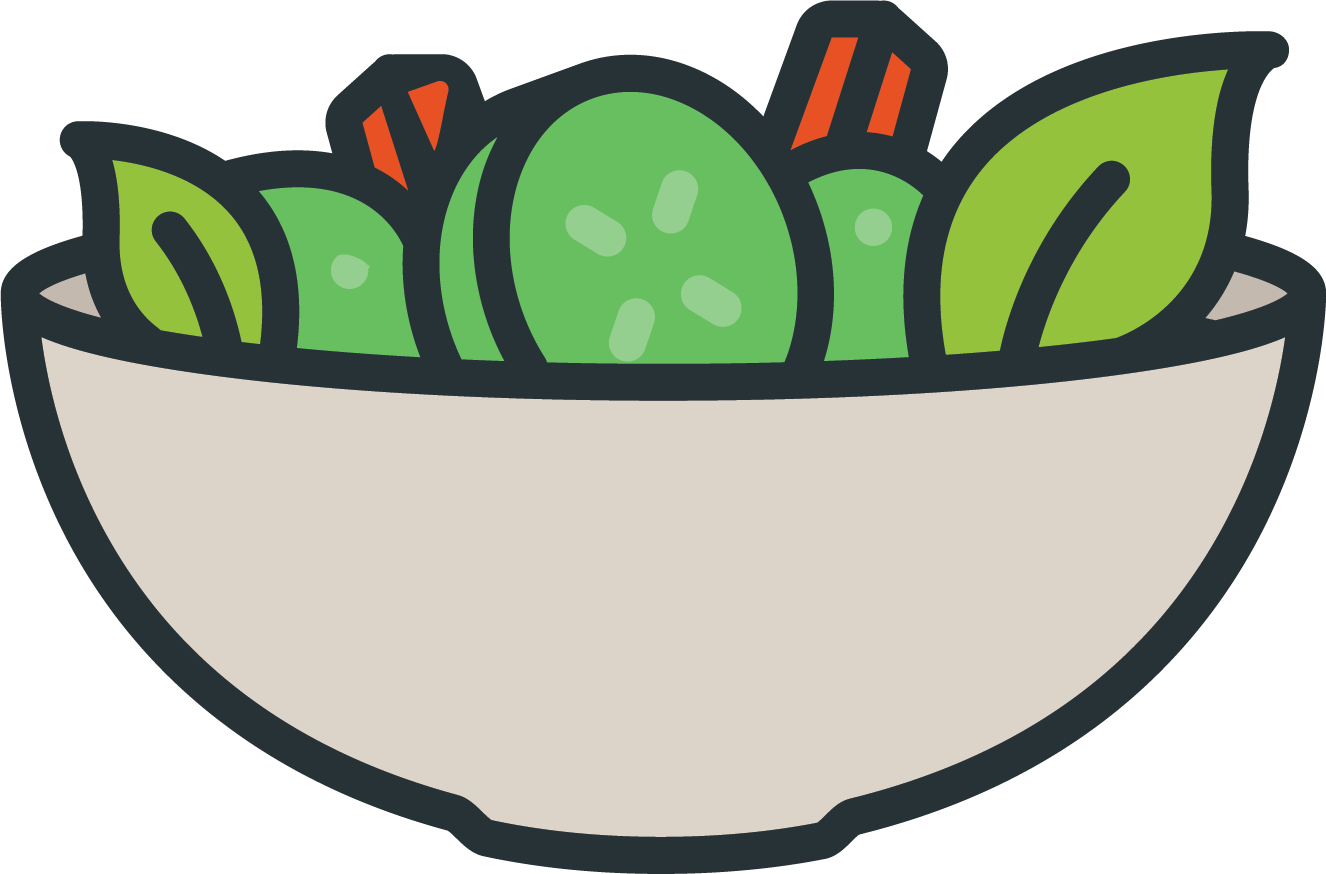 Salads
Salads Savoury Pastries
Savoury Pastries Jams
Jams Quick and Easy
Quick and Easy Sauces & Pastes
Sauces & Pastes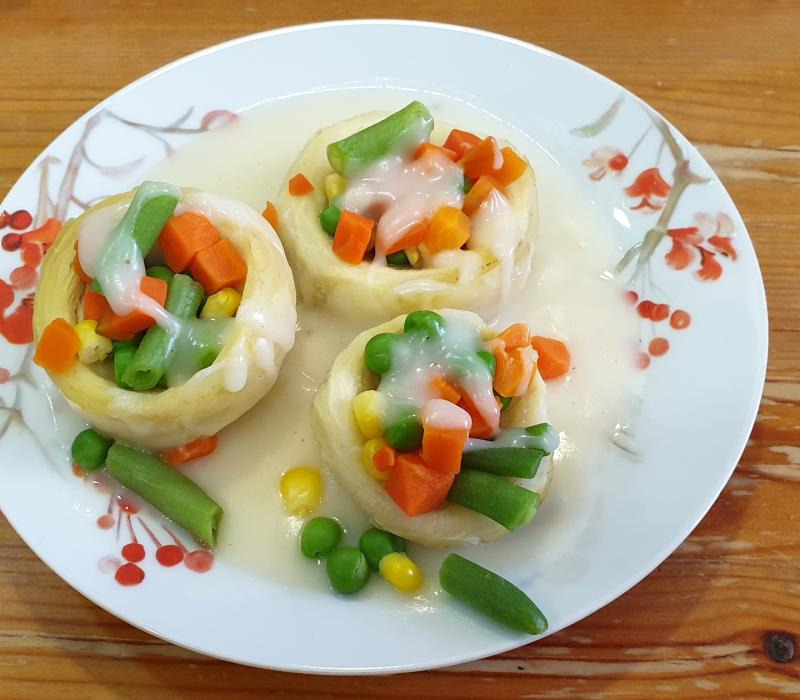




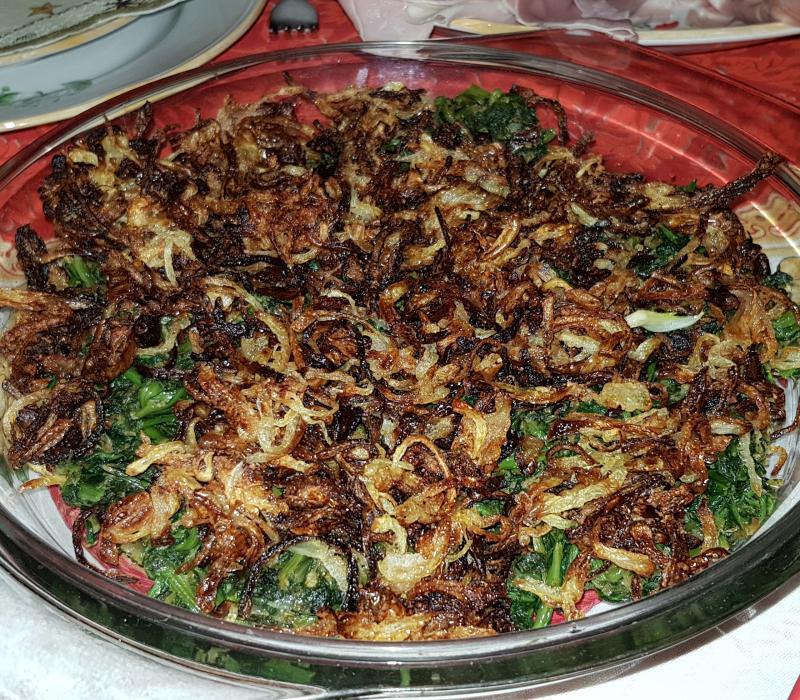
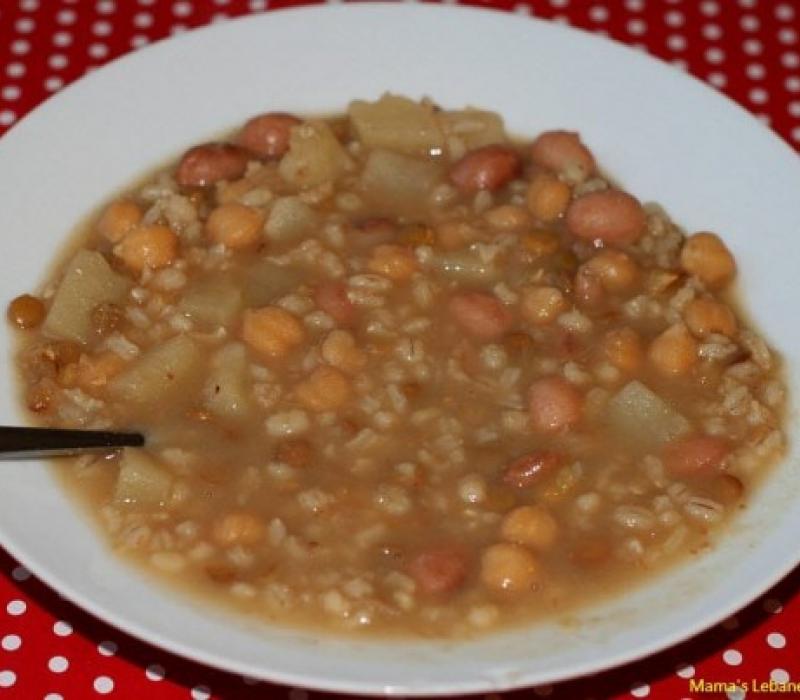
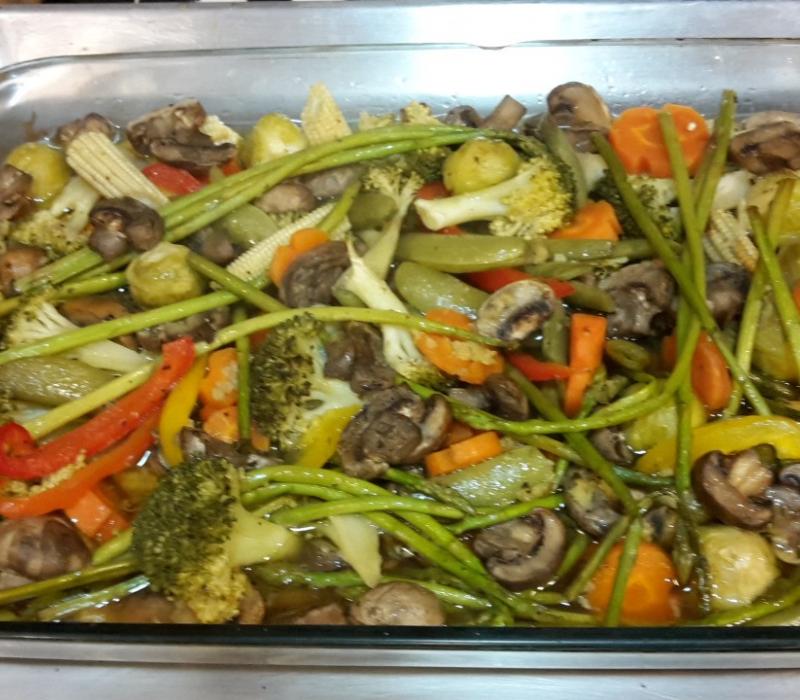

 New recipes
New recipes Cheery pickings
Cheery pickings  About Mama Lena
About Mama Lena